We went in search of Rodin, but found Lincoln. Yesterday, members of the Untapped New York team took a road trip to New Jersey. First on the list was a time capsule we’ve been following for some time (more to come on that in a future article). But second was to see a bona fide Rodin sculpture of Napoleon in Madison, New Jersey that was purportedly in the Hartley Dodge Memorial Building, used as the borough hall. A few years ago, the marble sculpture burst onto the international news scene with its “rediscovery,” which was even covered by The New York Times.
However, a staff member in Borough Hall told us that the angle of the story bothered them: the statue had always been prominently displayed in the Council Chambers on the second floor of the building and its provenance had been mentioned in various historical accounts. After all, the Hartley Dodge Memorial Building had been constructed by Geraldine R. Dodge (born Ethel Geraldine Rockefeller, the daughter of William Rockefeller). She is the revered benefactress of the town, who gifted the municipal building in honor of her only son, Marcellus Harley Dodge Jr., who had been killed in a car accident in southwestern France following his graduation from Princeton University. Mrs. Dodge’s gift also provided for a “perpetual endowment” for the maintenance of the building, reported the Madison Eagle in 1931 and she was granted “complete, uninterrupted control” of the plans and construction work. No expense was spared, with perfect slabs of marble acquired from a quarry in West Chelmsford, Massachusetts, along with marble for the interior from Belgium, Vermont and Colorado, and solid bronze details throughout the building. The building ended up 60% above budget at a cost of $800,000, which would be equivalent to $14.8 million in 2018 dollars.
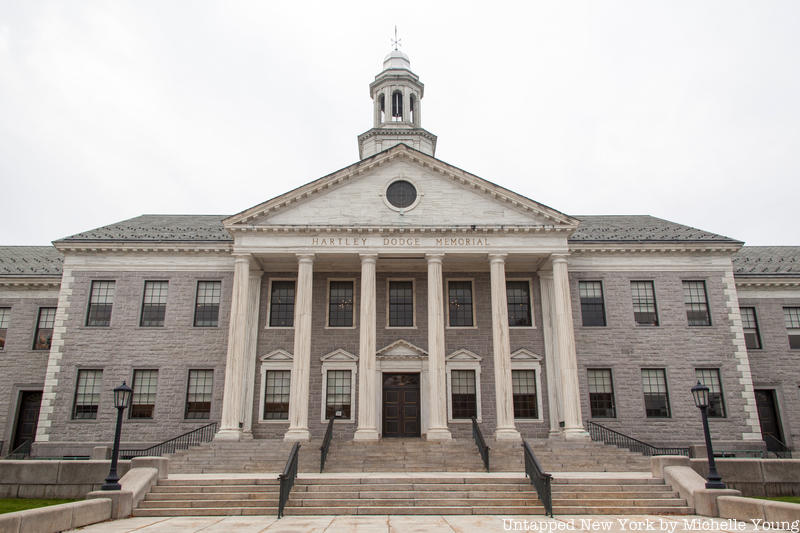
Dodge later presented works of art from her significant personal collection, including five oil paintings, marble reliefs, and three pedestals with busts for the residents of Madison to enjoy. These works were not gifts, but effectively loans, which have been managed by the Geraldine R. Dodge Foundation. One of the historical accounts mentioned by the borough hall staffer was a pamphlet, originally written in 1950 by the Borough of Madison with the support of the Geraldine R. Dodge Foundation. It mentions, among the many works presented to the borough by Dodge, “Napoleon in marble by August Rodin.” A reprint of this is available at the clerk’s office, offered as an informational history on the building. Nonetheless, it appears that there were no official records to authenticate the sculpture officially as a Rodin, and it all came to a head as an impending renovation was about to take place of the building in 2014. A graduate student named Mallory Mortillaro, who was hired as an archivist, asked in a meeting “So what are you going to do with the Rodin?” Mortillaro worked with an expert at the Rodin Museum in Paris, who helped her track down a descendent of a previous owner, and eventually the Rodin expert flew over and authenticated the Napoleon bust as a bona fide Rodin.
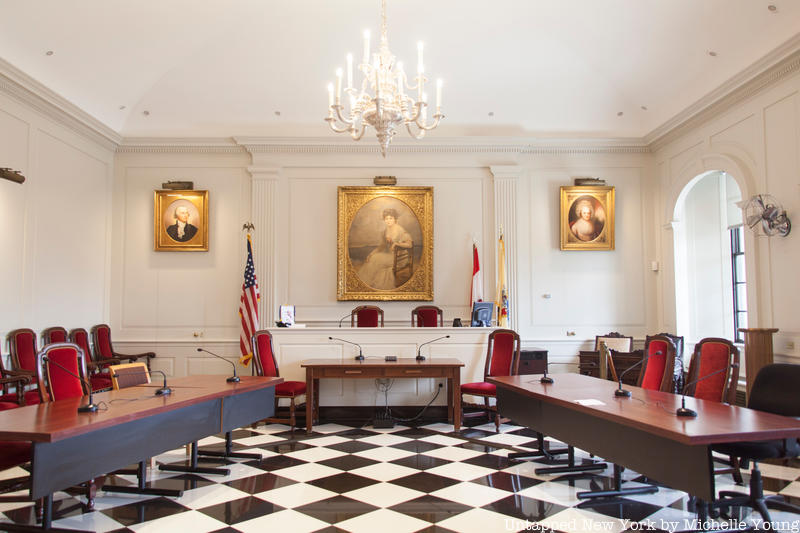 Inside the Council Chambers in Madison, NJ. A portrait of Geraldine R. Dodge is at center, painted by Freidrich A. Von Kaulbach.
Inside the Council Chambers in Madison, NJ. A portrait of Geraldine R. Dodge is at center, painted by Freidrich A. Von Kaulbach.
Following the media frenzy over the Rodin Napoleon, the bust was loaned to the Rodin Museum in Philadelphia for an exhibition, sub-loaned by the museum, and earlier this year, acquired by a private buyer through auction for a rumored $8 million. The bust, entitled “Napoléon Enveloppé Dans Son Rêve,” or “Napoleon Wrapped in His Dream,” will therefore not return to Madison, but according to New Jersey Hills, no other works of art are planned to be sold from the borough hall. That includes one piece, unlisted in the pamphlet we were given, but revealed to us on our visit by a clerk with a gleam in her eye. Upstairs in the Council Chamber, you’ll find a desk rumored to belong to Abraham Lincoln, she said in nearly a whisper. Then even more intriguingly, she said that the room is normally alarmed but she was sure a woman upstairs in a nearby office would be happy to disengage the alarm for us to take a look.
We headed up the grand marble staircase, and indeed, a kind staffer turned off the alarm, let us in to the room and turned on the lights. There it was, in a corner near the windows: an ornate wooden desk with built-in inkwells, elaborate carvings, and two drawers. The Madison Historical Society writes on its website that it was a desk used by Abraham Lincoln while he was in the House of Representatives. The New York Times repeats this claim in a 2017 article about the Rodin. This would mean that Lincoln would have been using the wooden desk with ornate carvings when he served as the representative from Illinois’ 7th Congressional District between March 1847 and March 1849. Lincoln had stated he would only serve one term in Congress and when he was not appointed a position he hoped for in the Taylor presidency, he went back to Illinois to work as a prairie lawyer until he was pulled back into politics with the question of slavery.
Upon further research into the furniture of the House of Representatives (luckily it’s well-documented on the History, Art, and Archives section of the House of Representatives website), the desk appears to be a double version of the Walter Desk, which was designed by Thomas U. Walter, the Architect of the Capitol and manufactured by Doe, Hazelton Company for the new House Chamber in 1857. The website explains that 262 of these oak desks were supplied for the House of Representatives chamber, inside the new U.S. Capitol building. In Madison, we weren’t told anything about the importance of the chairs, but they do appear to be the same model of the chairs that accompanied these desks in the House. And upon further research, the model of chair was used by the famous photographer Matthew B. Brady in numerous portraits from the Civil War, including the photo of Abraham Lincoln and his son Tad a day before Lincoln’s assassination. Brady acquired the chair around 1860.

According to the House of Representatives website, the furniture was “made in the Renaissance revival mode, a historical revival style fashionable in the Victorian period, the 262 oak desks and chairs were both sturdy and ornate. The profusion of decorative details was not just an expression of the period’s prevalent taste for flamboyant embellishment. The concept of Manifest Destiny—the nation’s ambition to expand westward across the continent—is illustrated on the desk fronts, which are decorated with a carved globe with “America” emblazoned across it. A shield with stars and stripes is carved above the globe, on the top rail, emphasizing the Union. The matching chairs have a similar decorative treatment. Along the top rail, the stars-and-stripes shield is flanked by an oak branch and a laurel branch. Traditional symbols of longevity and victory, respectively, they symbolically enforce the idea of the Union spreading across North America and beyond, an ideology that underpinned hope for the future of the nation during the sectional crisis and the impending Civil War.” Also according to the U.S. House of Representatives, the inkwell was sunk into the desk “so that it could not be taken by ‘prying messengers and pages.'” A necessary innovation in an era before smartphones.
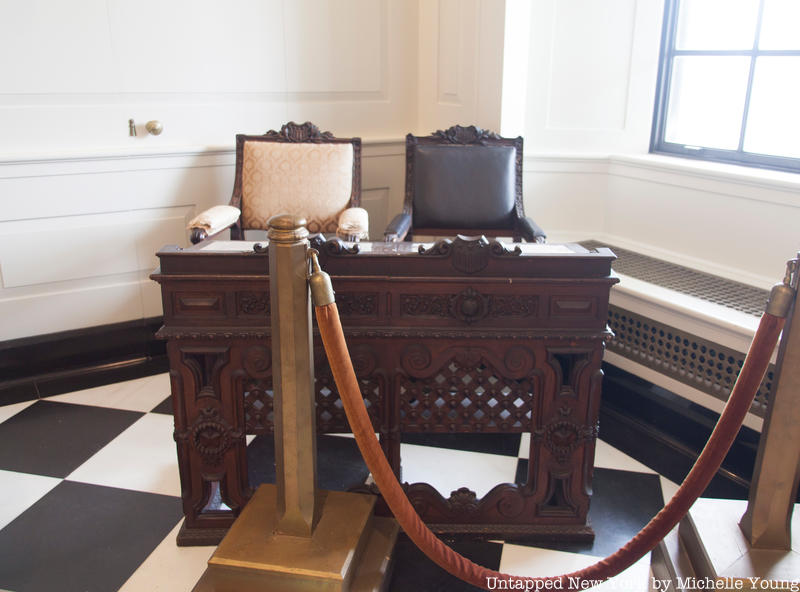
According to an auction of one of the Walter desks with Live Auctioneers, there were two versions of the desk. The single desk, which is shown on the House of Representatives website, and a “two compartment desk” which is the one seen in the Madison County council chambers room. In addition, it provides additional information about the dates surrounding the commissioning of the furniture in the House of Representatives: “Chairs for the U.S. House Chamber had already been ordered from the Bembe and Kimball firm of New York when Montgomery Meigs, who supervised the construction of the wings and dome of the Capitol from 1853 to 1859, sent images of the chair design to the Doe Hazelton firm of Boston for construction of 262 of the accompanying desks. The desks were in use until 1873 when they were gifted or sold to Congressmen.” Another Live Auctioneers listing has a double desk, described as “incredibly rare” and notes that it was actually shared by two Congressmen on opposite sides of the political spectrum!: Hon. Oakes Ames, a Republican from North Easton, Massachusetts and Hon. Stevenson Archer, a Democrat from Bellair, Maryland. The original name tags were still on this desk.
As fascinating as furniture history may be, what this leave us with is a conundrum. All of the accounts, whether government or from auctions that we have come across for this desk model have no earlier fabrication date than 1857 when the new House of Representatives was inaugurated. Even if the desks were designed earlier and perhaps in use earlier than 1857, Thomas U. Walter, Architect of the Capitol who designed the desk, was only in office starting from 1851, which is past the period when Lincoln was in the House. Montgomery Meigs, who was said to have been the one who sent the images of the chair to Doe Hazelton according to the Live Auctioneers account, was only appointed in 1853 by Jefferson Davis to run the construction, funding and logistics of building the new Capitol. Again, all after Lincoln’s time in the House of Representatives.
The History, Art, and Archives department of the House of Representatives states on its website that the desk and chairs were only in use from 1857 to 1873. After that, the desk and chairs were gifted or sold, and ended up in many private collections. It could become an easy assumption to associate the furniture with Lincoln, since he was photographed in it. But it does appear that what was reported in The New York Times as a desk used by Lincoln and the local historical society, is not correct. Following the initial publication of this article, we received a reply from Janet W. Foster, an Architectural Historian & Historic Preservation Consultant who is a resident of Madison and a Trustee of the Hartley Dodge Memorial, who further confirmed that “The desk in our Council Room was probably sold to Mrs. Dodge as a ‘Lincoln desk’ but it was not one he sat at when he served in Congress.”
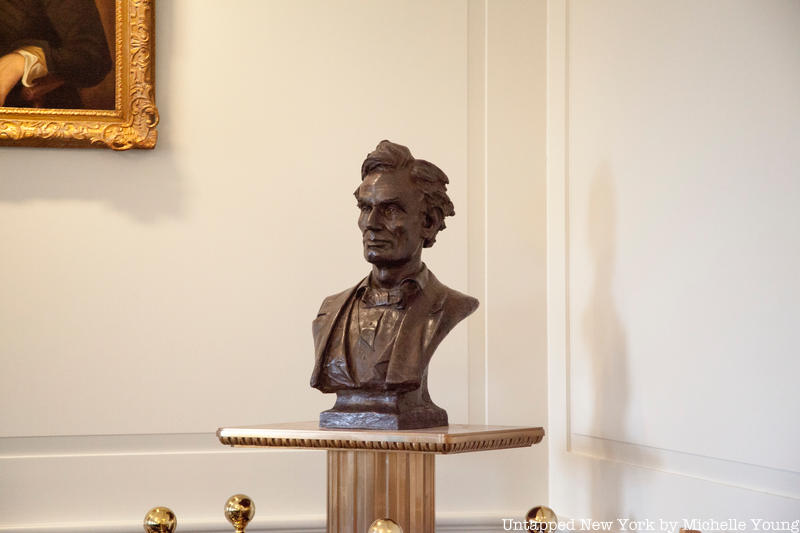
Regardless of the authenticity of the “Lincoln desk,” The Madison Historical Society notes that the desk is part of a larger Lincoln collection in the council chambers, which includes a bust of Lincoln in bronze by the sculptor Max Bachman and rare full length portrait of the president by Willem Karel Frederick Travers. According to the Caproni Collection, Bachman made two busts of Lincoln, one bearded and one without. The firm P.P. Caproni and Brother “distributed copies of both busts widely around the turn of the 20th century. Public monuments combined the Bachmann busts on a body modeled after the Standing Lincoln sculpted by Augustus Saint-Gaudens.” The version in Madison is the beardless Lincoln. Another sculpture from the original loan from Mrs. Dodge is a bronze bust of Benjamin Franklin by renowned French sculptor Jean-Antoine Houdon, most notable in the United States for his sculptures of George Washington.
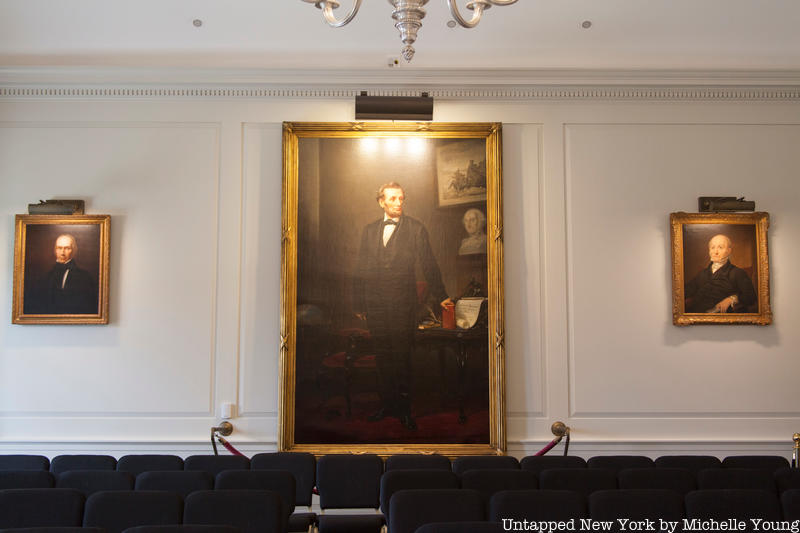 Portrait of Lincoln Willem Karel Frederick Travers
Portrait of Lincoln Willem Karel Frederick Travers
Madison, New Jersey is worth a larger visit as well, beyond the Hartley Dodge Memorial Building. Named the #1 place to live in New Jersey by NJ Monthly, and dubbed “A town straight out of central casting” by The New York Times, Madison is a college town with a quaint main street, diverse population thanks to the two colleges Drew University and Fairleigh Dickinson University’s College at Florham, and stunning architecture. Its NJ transit train station looks like a Gilded Age estate, designed by the company architect of what was then the Delaware, Lackawanna and Western Railroad. Listed on the National Register for Historic Places, the collegiate Gothic train station built of Gneise stone and oak interiors has a grand hall and Guastavino tiling in the entrance.
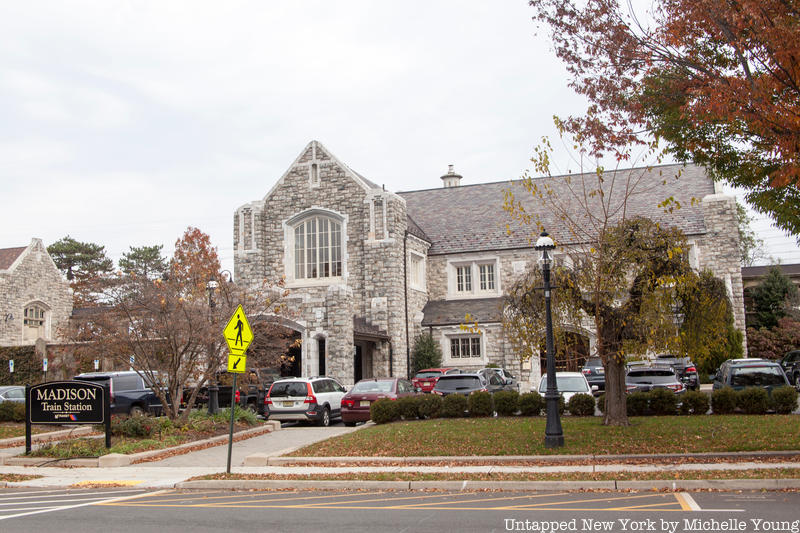 Madison Train Station
Madison Train Station
We’ll keep readers posted on any further developments on this desk supposedly used by Abraham Lincoln!
Next, check out 10 Historical Sites to Check out in Princeton, New Jersey.






